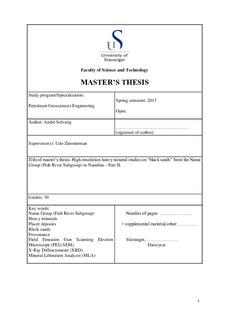| dc.description.abstract | “Black sands” from a presumed heavy mineral placer of the Nama Group in Namibia will be studied in detail. The samples for this thesis are collected from various outcrops belonging to the Fish River Subgroup in the Nababis Formation. This formation lies in the Nama Basin, in which the Haribes Member is deposited. High-resolution heavy mineral stratigraphy for the succession will be used to determine provenance of the detrital material. To achieve this, a methodical approach will be used where geochemistry, XRD (X-Ray Diffraction), and semi-quantification of heavy minerals using MLA (Mineral Liberation Analyzer) are combined with FEG-SEM-BSE-EDS-CL (Field Emission Gun Scanning Electron Microscope, Back Scattered Electron, Energy Dispersive Spectrometer and Cathodoluminescence).
Heavy mineral size distribution suggests normal size distribution with peaks around 125-150 microns for all samples, with one exception, Zf 409, which has bimodal size distribution in the range of 75 – 125 microns. Furthermore, all heavy mineral particles are generally angular to sub-angular, which can infer a short transportation route. The samples display relative similar mineralogy according to FEG-SEM and MLA analyses. One can suggest a proximal metamorphic source based on findings of i.e. chamosite, garnets, clinopyroxene, as well as the possibility of the identified grossular are Ca-epidotes according to XRD analysis. Moreover, the chemical composition of garnets was plotted in ternary diagrams, which show evidence of amphibolite facies and metabasic rock associations.
Provenance studies can be very useful to determine the tectonic setting of the sedimentary successions and the detrital material. By determining the main characteristics of the depositional basins and the source areas of the deposited detritus, it is possible to understand sedimentological processes. This is one of the important sources of information for the mineral and petroleum industry that need to evaluate potential plays. | nb_NO |
